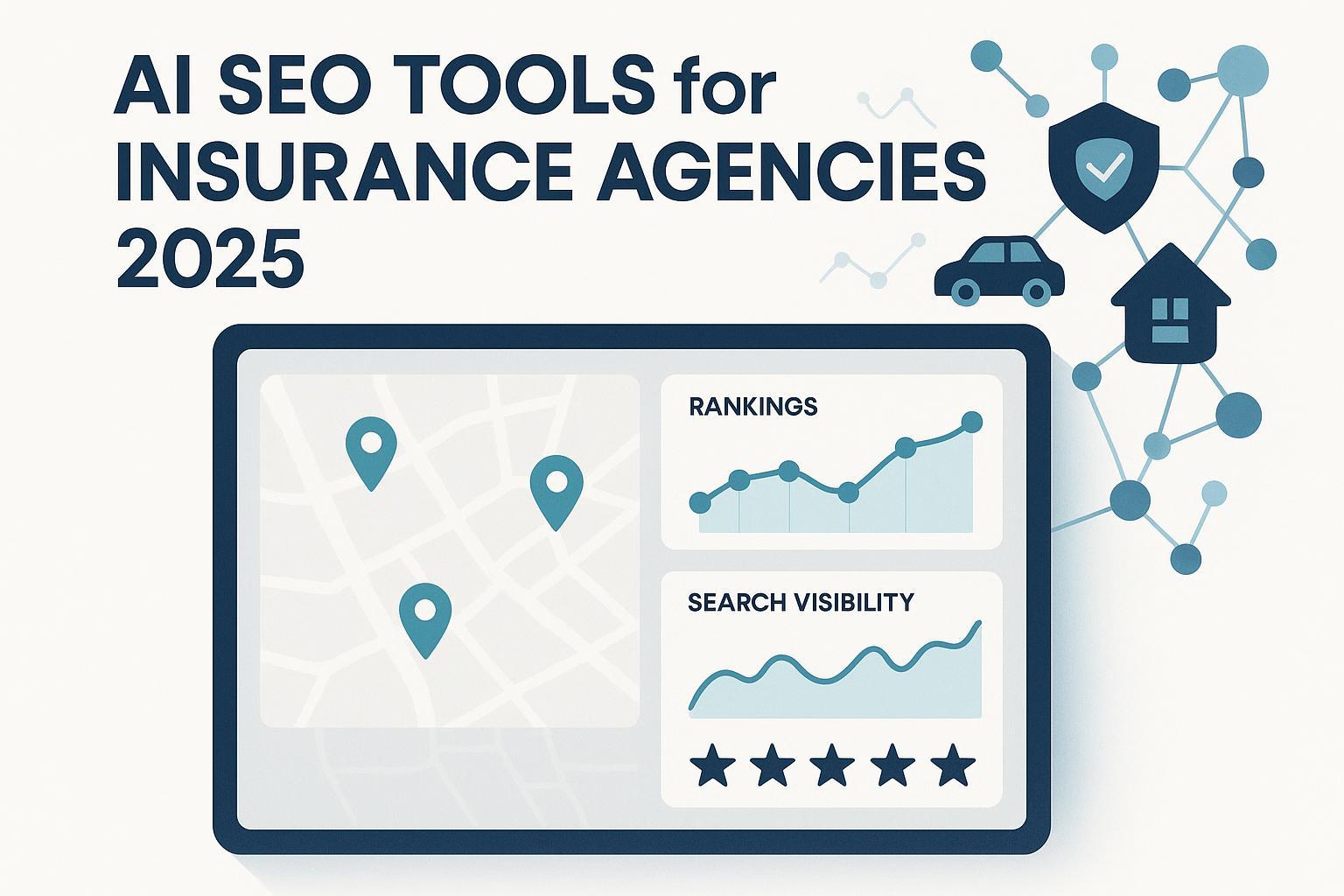Best AI SEO Tools for Insurance Agencies in 2025

If you run an insurance agency, 2025’s search landscape is a double bind: CPCs keep climbing, while AI Overviews and local packs siphon organic clicks. The right AI-powered SEO stack helps you publish compliant, E-E-A-T-friendly content faster, win more local visibility, and protect rankings from technical mishaps. Below is a carefully curated list mapped to insurance-specific tasks like compliant content creation, Google Business Profile (GBP) management, reviews, schema, and always-on technical monitoring.
Selection criteria you can trust
- Insurance relevance: E-E-A-T support, YMYL safeguards, and workflows that fit regulated content.
- Local SEO impact: GBP features, geo-rank tracking, listings accuracy, reviews.
- Practical AI: Real, actionable automation—not gimmicks.
- Scalability: From solo agents to multi-location groups.
Pro tip: Even with AI, all YMYL pages (insurance absolutely qualifies) should be reviewed by a licensed expert and cite authoritative sources.
1) QuickCreator — AI blog creation + real-time SERP insights
- Best for: Fast, SEO-friendly insurance blogs, service/location pages, and bilingual (EN/ES) content with one-click WordPress publishing.
- Why it stands out: QuickCreator blends AI writing with real-time SERP/topic guidance and built-in SEO optimization, plus multilingual generation and integrated hosting/collaboration. See the product capabilities described on the official QuickCreator AI Blog Writer page and its 2025 overview of AI SEO tools with SERP analysis.
- How an agency would use it: Draft “Dallas car insurance” pages with localized proof, build FAQ sections for coverage questions, and publish straight to WordPress in one click.
- Pitfall to avoid: Don’t ship AI drafts without licensed-expert review on YMYL topics.
2) Clearscope — Semantic coverage and search intent for policy pages
- Best for: Ensuring your policy, comparison, and local service pages comprehensively cover searcher intent.
- Why it stands out: The Content Editor grades topical depth and readability, guiding writers toward complete coverage. Their 2024–2025 product updates expanded AI-generated outlines and added integrations. See Clearscope Optimize and the April 2024 updates on Clearscope’s blog.
- How an agency would use it: Optimize “homeowners insurance deductible” and “commercial auto coverage Texas” pages to cover all entities and questions.
- Pitfall to avoid: Don’t obsess over the grade—prioritize factual accuracy and citations.
3) Surfer SEO — Data-driven content editor and AI drafting
- Best for: Rapid drafting and optimization backed by SERP patterns, then refined by your subject-matter experts.
- Why it stands out: Surfer’s Content Editor and Surfer AI accelerate outline and draft creation, while new 2025 updates add a unified dashboard and deeper SERP templates. Review the July 2025 highlights in “What’s New at Surfer”.
- How an agency would use it: Spin up localized landing pages (“best life insurance in Tampa”), then add expert-reviewed examples and citations.
- Pitfall to avoid: Don’t rely solely on AI tone—ensure it matches your brand and compliance standards.
4) BrightLocal — GBP management, geo-grid rank tracking, and reviews
- Best for: Local visibility across Maps and organic, especially for multi-agent offices.
- Why it stands out: BrightLocal centralizes GBP edits/sync, tracks rankings on a geo-grid, and streamlines reputation tasks. Their guide to supercharging Google Business Profile with Active Sync explains the control you gain over suggested edits and data consistency.
- How an agency would use it: Monitor “auto insurance near me” across neighborhoods, reply to reviews, and keep services/products updated in GBP.
- Pitfall to avoid: Don’t set-and-forget GBP—keep categories, services, and hours accurate.
5) Yext — Listings at scale + AI-powered governance (enterprise)
- Best for: Multi-location insurance groups needing centralized, governed listings and GBP sync.
- Why it stands out: Yext’s 2025 releases add AI-driven recommendations, expanded integrations, and deeper listings insights. See the June 2025 release notes for recent enhancements.
- How an agency would use it: Ensure every agent/location’s NAP data is correct across directories; roll out updates globally.
- Pitfall to avoid: Over-customizing fields you can’t maintain—set a governance model first.
6) Moz Local — Listings + reviews + social scheduling with AI assists
- Best for: SMB to mid-market agencies that want dependable listings sync plus light social/review workflows.
- Why it stands out: Listings AI highlights high-impact profile updates; built-in review monitoring and a social scheduler help you keep profiles fresh. Check the docs for Listings AI.
- How an agency would use it: Push consistent NAP across aggregators, schedule GBP/Facebook posts per location, track sentiment.
- Pitfall to avoid: Remember that some replies post natively—confirm workflow before promising SLAs to clients.
7) Conductor Monitoring (formerly ContentKing) — Always-on technical alerts
- Best for: Preventing traffic loss from accidental changes to mission-critical pages.
- Why it stands out: Real-time crawling and alerting catch indexability issues, broken links, and unapproved edits. It also introduces AI crawler visibility tracking. Explore Conductor’s 24/7 monitoring feature.
- How an agency would use it: Get Slack alerts if the “Claims” or “Auto Insurance” pages get noindexed or 404 after a CMS update.
- Pitfall to avoid: Don’t ignore alert severity—triage issues with business impact in mind.
8) JetOctopus — Deep technical crawls and log analysis
- Best for: Periodic technical audits and large-site diagnostics.
- Why it stands out: High-speed crawling, JS rendering, and log analysis help pinpoint indexation and performance gaps that hurt local rankings. Review their core features overview.
- How an agency would use it: Audit thin location pages, diagnose blocked resources, and validate internal linking to priority services.
- Pitfall to avoid: Crawls are only as good as follow-through—assign fixes and re-crawl.
9) Rank Math (WordPress) — Schema builder for LocalBusiness, FAQ, HowTo
- Best for: WordPress-hosted insurance sites that want rich results from clean schema.
- Why it stands out: Rank Math makes it straightforward to add LocalBusiness and FAQ schema with customization options and regular updates. See the official WordPress plugin page.
- How an agency would use it: Add LocalBusiness schema to each location page and FAQ schema to “How claims work” pages to earn rich results.
- Pitfall to avoid: Don’t abuse FAQ schema; only mark up questions actually answered on-page.
10) Podium — SMS-first review generation with AI reply assistance
- Best for: Increasing review velocity and maintaining professional, compliant responses.
- Why it stands out: Podium streamlines SMS/email review requests and drafts AI-assisted replies within a unified inbox. See Podium’s feature updates in What’s New.
- How an agency would use it: Trigger review invites after claims support interactions and manage replies across multiple agents.
- Pitfall to avoid: Adhere to SMS consent rules; do not incentivize reviews.
11) Birdeye — Enterprise-grade reputation + listings + messaging
- Best for: Multi-location agencies that need analytics-rich review, listings, and messaging workflows.
- Why it stands out: Birdeye offers AI assistance for reviews and centralized listings with guidance for optimizing GBP. See their Google Business Profile optimization guide.
- How an agency would use it: Monitor sentiment across locations, standardize responses, and keep directory listings accurate.
- Pitfall to avoid: Configure permissions carefully so local teams have the right access without risking inconsistent messaging.
12) Merkle Schema Markup Generator — Quick JSON-LD for LocalBusiness/FAQ
- Best for: Non-WordPress stacks or one-off schema needs.
- Why it stands out: Generates compliant JSON-LD for LocalBusiness, FAQPage, and HowTo that aligns with Google’s structured data guidance. Use the Merkle schema generator and validate against Google’s Local Business structured data documentation.
- How an agency would use it: Paste LocalBusiness and FAQ JSON-LD into your CMS for each location/service page.
- Pitfall to avoid: Keep schema fields truthful and synced with on-page content.
13) Scalenut or NeuronWriter — Budget-friendly editors for SMB teams
- Best for: Cost-conscious agencies that still want NLP-guided optimization.
- Why it stands out: Both tools provide SERP-informed briefs and semantic suggestions at SMB-friendly prices. Explore Scalenut or NeuronWriter and compare plans for your workload.
- How an agency would use it: Create briefs for “renters insurance coverage” topics, then layer in examples and citations.
- Pitfall to avoid: Don’t chase term stuffing—focus on clarity and helpfulness.
14) Conductor AI — Track visibility in AI answers (enterprise)
- Best for: Carriers and large agencies that must understand presence in AI Overviews and answer engines.
- Why it stands out: Conductor AI adds AI Topic Maps and visibility tracking across AI Overviews and LLMs, plus Writing Assistant tools. See the platform’s AI overview.
- How an agency would use it: Identify gaps where competitors appear in AI answers (claims steps, coverage definitions) and plan content to win inclusion.
- Pitfall to avoid: Don’t chase AI answers at the expense of traditional SEO fundamentals.
Mini playbooks that work in insurance
- Lean solo stack (quick wins): QuickCreator (drafts + publishing) + BrightLocal (GBP + ranks) + Rank Math (schema). Publish one optimized city page per week and add 3–5 real local proof elements (photos, testimonials) each time.
- Growing team (5–20 agents): QuickCreator + Clearscope/Surfer for optimization + BrightLocal for local + Podium for reviews + Conductor Monitoring for real-time alerts. Goal: standardize location page templates and review workflows.
- Multi-location/enterprise: Clearscope for content quality + Yext for listings governance + Birdeye for reputation + JetOctopus for crawls + Conductor AI for AEO visibility.
Checklist: ship E-E-A-T insurance content, safely
- Author and reviewer: Name a licensed expert reviewer on every YMYL page; keep revision logs.
- Sources and citations: Link to primary, authoritative references (carriers, regulators) where claims are made.
- Local proof: Photos, team bios, local partnerships, and location-specific FAQs.
- Schema: LocalBusiness on every location page; FAQ on coverage explainers; validate regularly.
- GBP hygiene: Correct categories, services, hours; post updates; respond to reviews.
- Technical guardrails: Monitor indexability, errors, and performance after each deploy.
Light-touch CTA
- If you want faster, compliant content production with built-in SERP guidance and one-click WordPress publishing, explore QuickCreator. Pair it with a semantic editor (Clearscope or Surfer) and a local/reputation tool (BrightLocal, Podium) to cover the full funnel.

